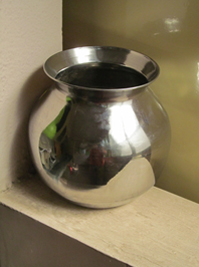David Stairs
“The search for form demands an investigation into values and qualities that Indians hold important to a good life.” —Charles and Ray Eames, The India Report, 1958


The lota: universal, indispensable, praised by Charles Eames. An instance of Indian design so unique as to be eternally linked to the subcontinent. Scalable, stackable, the Eames didn’t think it could have been designed by one person, but rather refined by generations. It comes in many materials, clay, copper, brass, steel, plastic, and in many sizes. Its purpose, to hold water, is an important one. India’s is a hot climate, and a vessel that can store cool water without spilling it or allowing it to evaporate is valuable. It has a secondary purpose: to hold the water used to wash oneself after defecating. Some lotas designed for this purpose have a spout. Of all the processes employed to make lotas, all but ceramics are labor intensive and involve hammering (chasing), stamping, or molten casting. These, of course, are the traditional methods of manipulating metal. So now it occurs to me to ask whether there might be a newer, more appropriate candidate for universal form in India in an age of sustainability?


The Indian concept of jugaad, meaning everything from jerry-rigged to workaround to Steve Daniel’s term “making do”, is enjoying current favor. An exhibition, Jugaad Urbanism, debuted in New York in 2011 to moderate acclaim. Having seen nearly everything from Bajaj autorickshaws to Tata Nanos described as jugaad influenced, I’m a little hesitant to make this proposal as there’s grown up a sort of everything-and-nothing attitude about the DIY concept. Eames’s India Report was a proposal for a design school that could “provide the trainee with a questioning approach and a smell for appropriateness.”
Oddly enough, I found an excellent instance of this right in the very same Yesvantpur market where I purchased these lotas. Leaves are used for a variety of things the world over. In an earlier post here I offered some African examples. Originating in Tamil Nadu, the south Indian example is a simple plate made of arecanut palm leaves that are cleaned, heat stamped, and trimmed. In America such things are made of paper or, less intelligently, styrofoam. While both of these are also available in India, neither of these materials is easily biodegradable. The arecanut leaf plate, on the other hand, not only is functional, durable, and recyclable, but each plate has a unique pattern! And at 3 rupees apiece, it’s very affordable. 
Click image to view manufacturing process
As the 21st century rolls on into what promises to be an expanding human awareness of a human-caused environmental disaster, it’s possible that formalists, like Charles Eames, will come to seem old fashioned and be replaced by more ecologically-minded thinkers. The lota will continue to be used, of course, but so will the arecanut leaf plate. And hopefully, our techniques for making the simple objects of everyday necessity will expand to include not only the labor-intensive classically beautiful, but also the mundanely simple. Then we will have truly realized Eames’s goal for the NID, to “hasten the production of the “Lotas” of our time.”
David Stairs is the founding editor of Design-Altruism-Project











Leave a Reply
You must be logged in to post a comment.